Watching an old fight film last night
Ray Mancini vs. Duk Koo Kim
the boy from Seoul was hanging in good
but the pounding took to him
and there in the square he lay alone
without face, without crown
and the angel who looked upon
she never came down
Ray Mancini vs. Duk Koo Kim
the boy from Seoul was hanging in good
but the pounding took to him
and there in the square he lay alone
without face, without crown
and the angel who looked upon
she never came down
As usual, one of my posts is set off by something that catches my attention and then I proceed to track down as much information about it as possible. I have to say, I never thought I'd be posting about a boxing match, but it's all due to a song by Sun Kil Moon, Mark Kozelek's latest band, titled "Duk Koo Kim". Sun Kil Moon is named after a Korean boxer named Sung-Kil Moon, and when asked about two obvious dead boxers written about on their album "Ghosts of the Great Highway", Kozelek replied
There are actually more mentions than that: Pancho Villa was a Filipino boxer who died in the 1920s; Sal Sanchez; and Benet Paret, who was killed by Emile Griffith in the '60s. Sonny Liston also died relatively young. And Duk Koo Kim, as well. Boxing has been a fascination of mine for about 10 years now. I never thought any of these guys would find a way into my songs, but they all died young and tragically, and deserve the tribute. Their lives were very colourful, so it's easy to write about them.Listening to this song led me to try to find out more about Kim Deuk-gu. My first introduction to him had been, like most people, through the 2002 Korean film Champion.
Director Kwak Kyung-taek was a teenager when he saw this fight on TV. Like many Koreans who lived through that era, the event left a strong impression on him, and years later he decided to make a film in memory of Kim's determination and courage. "That was during an era when Korea was trying desperately to escape the poverty of the 60s and 70s, to cast off our reputation as a third world country," Kwak says. "For Koreans who remember him, Kim represents the last image of that generation and their hunger to succeed."Having seen the movie before, I decided to have a look on emule and see if there were any video files of Kim's last fight, against defending lightweight world champion Ray "Boom Boom" Mancini. There were, in fact, several files floating around, and screenshots from the actual fight follow. What's interesting are the differences between the actual fight and how it was portrayed in the film. For example, let's compare the film version of Kim (played by Yoo Oh-sung) and actual footage of him, for example, before the fight begins:
Did anyone else notice that they seem to have switched outfits? I have no idea why this change occurred, and I'm often confused by filmmakers who change details of recent history that has been filmed, when a visual record of the event still exists. It's not an important detail, true, but I still find it a bit odd.
The details of the fight come from Wikipedia's entries on Duk Koo Kim and Ray Mancini, as well as this article about the fight by Vaughn "Bigboscoe" Featherstone (from whom most of the match commentary is taken), who writes that
Having won 17 of 18 fights, Kim was assigned the number one ranking by the WBA against World Champion Ray "Boom Boom" Mancini although the caliber of competition he (Kim) had faced was nowhere near the Championship level that most challengers would have had to have in order to receice such an opportunity. Mancini was a rising star who had just come off two spectacular victories over World class fighters. Many saw Kim as undeserving and way over his head having fought only one fight outside his native South Korea with a 8th round TKO over Tony Flores in the Phillipines.Mancini and Kim met in an arena outside Caesar's Palace on November 13, 1982.
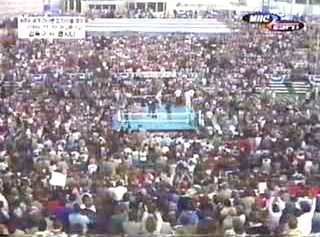
While it is obvious that the crowd is cheering for Mancini, Kim does have a small contingent of vocal supporters in the audience, who are often caught on camera cheering and waving Korean flags.
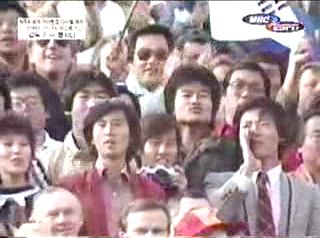
Kim had to lose several pounds before the fight to make the weight (135 pounds), and may have been dehydrated.
Through all of the media ridicule, the fight turned out to be very entertaining with Kim proving that he was a worthy challenger regardless of what his lack of big fight experience showed. Throughout the first 12 rounds, Mancini and the southpaw Kim went toe to toe landing big shots with neither fighter taking a step back.

Myself, as I viewed the fight, I thought that throughout most of it both men appeared to be evenly matched, with Mancini having a slight edge. Whenever he seemed to have the upper hand, however, Kim was usually able to match him, finishing the 8th round, for example, landing a series of blows to Mancini's head. By the the 10th round, however, the fight began to tilt in Mancini's favour.
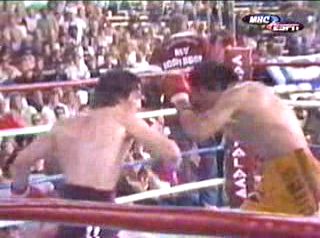
At the start of round 13, Mancini charged Kim and battered him with a barrage of unanswered punches. Referee Richard Greene could have very well stopped the fight because of Kim's lack of defense. However, the round shifted midway through as Kim began to pound Mancini inside. What began as a one-sided round for Mancini ended up being closer than anyone could have expected. Walking back to his corner after the 13th round, Kim looked battered but not yet ready to pack it in.
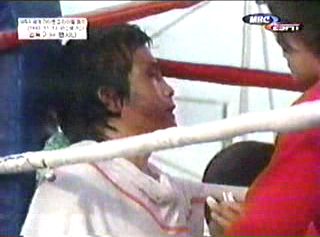
This is dramatized in the film:
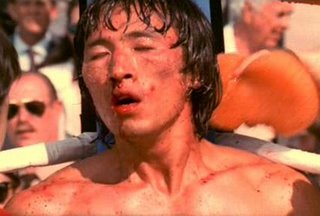
However, is it just me, or does Kim, in the film, look far more battered than he did in real life at that moment? Kim did not appear to be bleeding in the actual video of the match, and, as described above, Kim seemed to regroup after a rather sustained pounding by Mancini. In fact, it seemed to me that, had the bell not rung ending the 13th round, Kim might well have inflicted some more damage, as he seemed to have momentum behind him at that moment. However, in the film, there is no hint of this regrouping by Kim. He is simply beaten mercilessly, and then wanders around the ring, dazed for several seconds (rendered in slow motion) before sitting down in his corner. This bears little resemblence to how Kim actually acted in the last few minutes of his conscious life, but I guess it seems much more dramatic and tragic.
Round 14 began with both fighters charging out to center ring and looking to land a surprising shot. As Kim feinted a left hook, Mancini stepped to his right and countered with a left-right hook combination. Kim threw a two left hooks to the body. Mancini landed a chopping right hand that caught Kim flush on the bridge of the nose followed by a vicious left hook to the chin. Kim wobbled defenseless. Mancini then followed with another right-left hook combination with the straight right that sent Kim reeling backwards and flat on his back.This all took place in six seconds.
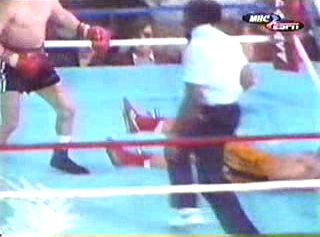
Kim rose with the assistance of the ropes but was in no shape to continue.
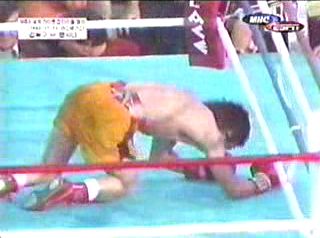
Minutes after the fight was over, Kim collapsed into a coma, and was taken to a hospital. Emergency brain surgery was done there to try to save his life, but that effort proved to be futile, as Kim lost his life 5 days after the bout, on November 18.
Mancini went to the funeral in South Korea, but he fell into a deep depression afterwards. He has said that the hardest moments came when people approached him and asked if he was the boxer who "killed" Duk Koo Kim.

Unfortunately, the tragic effects of the fight affected others beyond Kim and Mancini:
Referee Richard Greene committed suicide months after the fight, while Kim's mother did the same four months later. Mancini had a tough time continuing his career. Although he eventually stepped back into the ring, he was never the same fighter going 4-4 in his final 8 bouts. Possibly, had Greene stopped the fight in the 13th round, Kim may have lived. But hindsight is 20/20 and who knows? Kim's fateful injuries may have already been acquired. What could be described as eerie, Kim wrote on his hotel room's mirror, "Kill or be Killed."An image of the fight made the cover of Sports Illustrated weeks later under the title "Tragedy in the Ring", and Kim Deuk-gu's death ended up (inadvertantly) changing the sport of boxing, as title bouts were shortened from 15 rounds to 12 rounds, and more health checks were introduced.
I can't imagine what Mancini's experience at the funeral must have been like, or what the media reaction to his visit here would have been at the time (a few newspaper front pages about Kim's injuries after the fight can be found here). He did act as an advisor on Champion, however, (and reflected upon the fight and its effect on him, briefly recounted here and here), which seems like a very conciliatory thing to do on both the director and Mancini's part.
As I imagined the reaction in Korea at that time to the fight, another seemingly tragic sports moment came to my mind - when Son Gi-jeong won the gold medal in the marathon at the 1936 Olympics in Berlin, but was unable to celebrate his victory as a Korean, as Korea was under Japanese control at the time. Several photos of Son during that marathon, as well as other parts of his life, can be found here. You might compare those photos with the one the Donga Ilbo published:
As wikipedia tells us about that article,
One of Korea's domestic newspapers, Dong-a Ilbo, published a photograph of Sohn at the medal ceremony, but had altered the image to remove the Japanese flag from Sohn's uniform. This act so enraged the Japanese regime that it imprisoned eight persons connected with the newspaper and suspended the publication's operations for nine months.And this was during the more 'liberal' phase of Japan's control over Korea, and an example I should have mentioned here. At any rate, in August of this year a ceremony was held in Yokohoma to commemorate the 70th anniversary of Son's gold medal. At the ceremony,
Former Olympian and winner of the 1953 Boston Marathon, Keizo Yamada, said he decided to take up the marathon after watching Son's performance in Berlin. ''He was my idol,'' Yamada said with tears in his eyes.Son's son, Jong-in, said, ''I want the young generation to understand the history of the past and hope Japan and South Korea build a bright future upon it.''
Son made contributions to the world of South Korean sports after the war, and made efforts to improve relations between Japan and South Korea through sports.
I think that Keizo Yamada's idolization of Son is fascinating. Son did not just win glory for Korea, as is remembered today, he won glory for Japan, and, from Yamada's words, it seems Japanese people respected and even idolized him for it, which says interesting things about the intersection of sports and nationalism, wherein even 'problematic' ethnicity can be erased (witness the media circus in Korea after Hines Ward's performance in the Superbowl this year). But whereas Son tried to bring Korea and Japan closer through sports, and his son hopes for a brighter future between the two countries, it seems sports these days which involve Korea and Japan seem to invite a desire to create nationalist-fueled rivalries between the two countries.
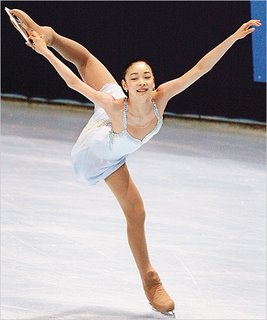
A recent example of this would be the winning of the Bompard Figure Skating Trophy by Korean figure skater Kim Yu-na in Paris (you can watch her performances here and here). As the Chosun Ilbo tells us,
She scored 184.54 points in the fourth round to beat her Japanese and U.S rivals Ando Miki (174.44 points) and Kimmie Meissner (158.03 points). Kim became the first Korean figure skater to win the title.A good background article on Kim by the Joongang Ilbo can be found here; it reveals that, as of early 2005, her country had done next to nothing to help her, and that her considerable training costs (hell, her current coach is Brian Orser) and transportation/entry costs for competitions have been born by her family. Yet when she won the World Junior Figure Skating Championship earlier this year, the media went wild:
Figure skating princess Kim Yu-na (16) on Friday accomplished a brilliant feat in Korean figure skating history by capturing the crown in the 2006 ISU World Junior Figure Skating Championship in Ljubljana, Slovenia. This is the first major win for a Korean since the sport was introduced here 111 years ago.In the lead up to the competition she just won, the Chosun Ilbo had an article titled "Korean Skater Up Against Massed Japanese Force", which, while true (Japanese skaters have been doing very well in figure skating for the past several years), seems to be putting a nationalist slant on the competition. While I could say, "The Korean media, putting a nationalist slant on a sporting event? Never!" it would only be fair to point out that this would describe media responses in many countries, and TV shows in both Korea and Japan have looked at (and propagated, of course) the Kim Yu-na / Mao Asada rivalry that exists in the minds of the media and netizens, but which may not exist in the minds of the two atheletes (other than in a "I want to win" sort of way).

This photo may be enough to make some ultra-nationalists froth at the mouth, but I have to say I'd much rather see this photo plastered on subway station walls and displayed at protests than photos of two teenaged girls run over by a tank...


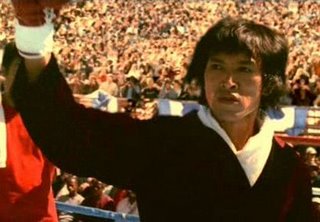

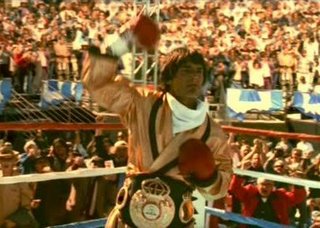


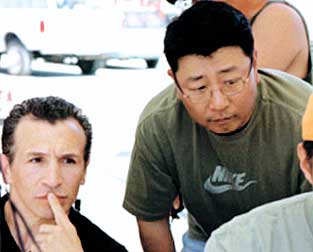

6 comments:
See if you can find a copy of "Ulji anheun Horangi", a movie made about the Kim Deok Koo story back in the 80's. A couple of friends (GI's) were in it, with CW2 John Paone starring as Mancini...
Actually, the cover to that film appears at the bottom of this post, but as the link is broken, it slipped my mind to follow up on it. A larger photo of the poster can be found here, and an imdb entry which gives only a basic plot outline can be found here. It seems the only way to track this down would be on vhs. Thanks for bringing it to my attention!
Fascinating post, as is standard for your blog. Thanks much.
Great post. Zevon did a song about Mancini. It's one of his best, I think, although he talks some liberties. Lyrics, for what they are worth, here
http://www.sing365.com/music/lyric.nsf/Boom-Boom-Mancini-lyrics-Warren-Zevon/1A62166B14973ADA48256C95000C2FC3
Hi Matt. Thanks for your comment over at my blog. Do you have an email address you could pass along to me? I won't post it publicly, but would like to get in touch with you, if that is okay.
Great job on the Kim article. Oh, this is Vaughn "Bigboscoe" Featherstone. Also, thanks for giving me credit on it. But this isnt about me, its about you and Kim. It's great that you posted what you did. Kim was underated and not really given much of a chance to compete against Mancini. IMO he gave Mancini a helluva fight and made that fight one of the best fights of that year. He stayed in Mancini's face and took everything Mancini could offer.
Although Kim tragically died, he proved to be a bigger champion in death.
Great job, bro!
I will be reposting the article at geocities.com/thirdman_boxing/editorials on 19 February 09.
Post a Comment